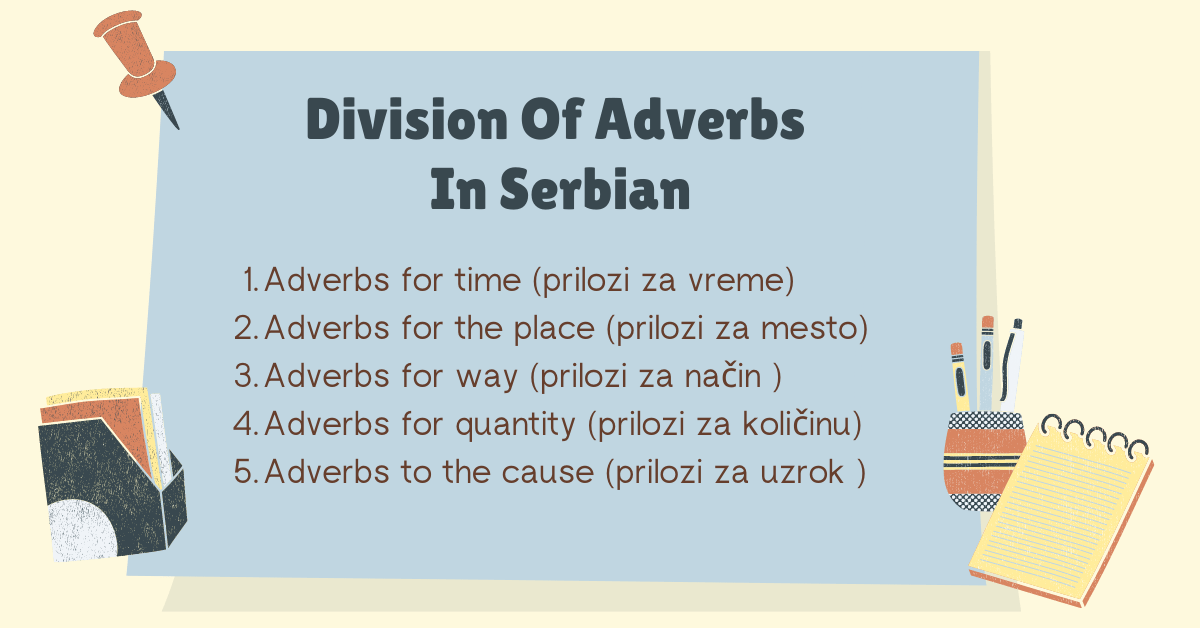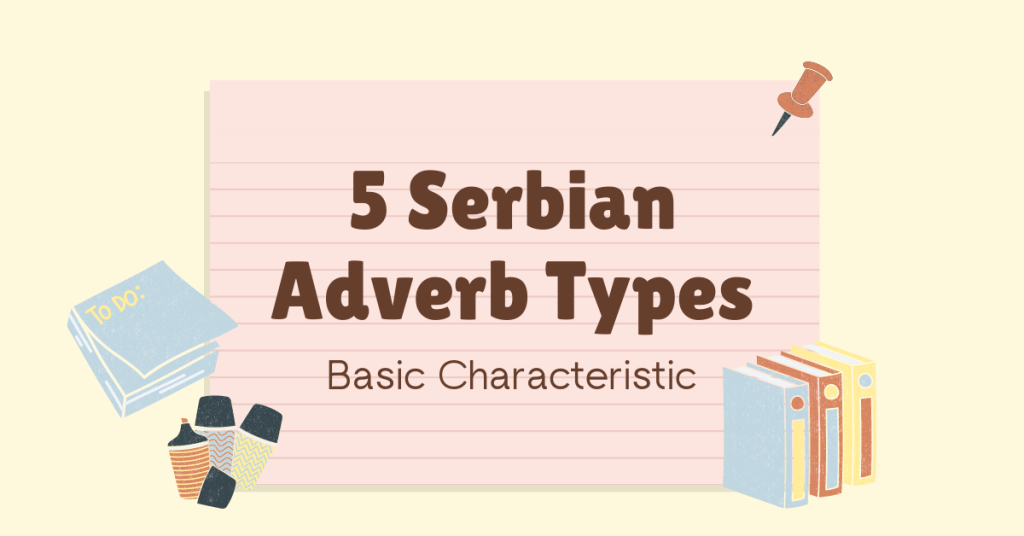There are 10 types of words in the Serbian language, of which 5 types are changeable, and 5 are immutable words. Serbian adverbs belong to the invariant type of word that is most often found next to a verb. They usually determine the verb action by time, place, manner, quantity, or cause but also can be used with adjectives, other adverbs, and nouns. In the sentence, they have the function of an adverbial clause. According to the Serbian grammatical tradition, adverbs are divided into right and wrong in relation to their origin.
Special forms of adverbs can be used to express a greater degree or quantity, differences in time and space, etc. Therefore, in addition to the basic form, the positive, they can also have the form of comparatives or superlatives, which will be discussed later. There are also complex adverbs that are formed from propositions and adverbs, for example, odatle ( from there), odozgo ( from above), unazad (backward), preksinoć ( the day before last), etc.
List Of Serbian Adverbs – Examples With Translation
Since the adverbs division will be explained below, here are a few examples to bring the matter closer to you. Serbian adverbs are numerous, so these are just some of the examples:
| Serbian | English translation |
| katkad | sometimes |
| danas | today |
| večeras | tonight |
| letos | last summer |
| odmalena | from childhood |
| odsad | from now on |
| odtad | from then on |
| izdaleka | from afar |
| spreda | in front |
| donekle | somewise |
| ovako | like this |
| ponajmanje | at least |
| premalo | too little |
| triput | three times |
| uzalud | in vain |
| nikamo | nowhere |
| rano | early |
| kasno | late |
| napokon | finally |
| nedavno | recently |
| izbliza | up close |
| nekuda | somewhere |
Division Of Adverbs In Serbian

With a better understanding of Serbian adverbs, you will improve your grammar knowledge. Since we have already clarified the concept and basics of the adverbs, their more detailed division follows below. According to how they determine the verb action, adverbs can be:
- Adverbs for time (prilozi za vreme)
- Adverbs for the place (prilozi za mesto)
- Adverbs for way (prilozi za način )
- Adverbs for quantity (prilozi za količinu)
- Adverbs to the cause (prilozi za uzrok )
Adverbs Of Time
When determining the adverbs of time, you will ask questions:
- kada (when)
- otkada (since when)
- andokada (until when)
In this regard examples of this type of adverbs are:
| Serbian | English translation |
| danas | today |
| večeras | tonight |
| jučer | yesterday |
| sinoć | last night |
| preksinoć | the day before last |
| ljetos | last summer |
| zimi | in winter |
| jesenas | last fall |
| odma | now |
| smjesta | immediately |
| tada | then |
| ikad | ever |
| uvek | always |
| često | often |
| retko | rarely |
| rano | early |
| kasno | late |
| prije | before |
| posle | after |
| potom | then |
| nedavno | recently |
| napokon | finally |
| odsad | from now |
| otad | since |
| oduvek | from time immemorial |
| dogodine | next year |
| dovečeras | until tonight |
Example sentences:
Pošle godine sam kupio auto. – I bought a car last year. ( determines the tense of the verb)
Jučer smo se provozali brodom. – We took a boat ride yesterday.
Neću igrati košarku jer sam nedavno izvrnuo zglob. – I’m not playing basketball because I recently twisted my wrist.
Adverbs Of Place
When it comes to adverbs of place, common questions to determine them are:
- gde (where)
- odakle (where from)
- dokle (until)
- otkuda (wherefrom)
- dokuda (to where)
- etc.
Serbian adverbs that determine the place of action are:
| Serbian | English translation |
| ovdje | here |
| negde | somewhere |
| igde | anywhere |
| gore | upstairs |
| dole | downstairs |
| vani | outside |
| spreda | in front |
| tamo | there, over there |
| niotkuda | out of nowhere |
| izdaleka | from far away |
| izvana | from the outside |
| donekle | somewise |
Example sentences:
Ispod nas živi komšija sa unucima. – Below us lives a neighbor with grandchildren.
Ne idite na trening, vani je velika oluja. – Don’t go to training, outside is a big storm.
Sjedili smo zajedno kada se on pojavio niotkuda. – We were sitting together when he appeared out of nowhere.
Adverbs For The Way
Adverbs for the way answer the question how (kako) and they are often represented in sentences. On questions about how (kako) the adverbs are ovako (like this), tako (in such a way), slučajno (by accident or accidentally).
Example sentences:
Prolazim šumom i slučajno vidim orla. – I walk through the woods and accidentally see an eagle. (how did you see an eagle)
Uzgajam ovo prelepo cveće. – I grow these beautiful flowers. (what flowers)
Adverbs For Quantity
Adverbs for quantity answer the questions:
- koliko (how much)
- koliko puta (how many times).
Examples are:
| Serbian | English translation |
| ovoliko | this much |
| toliko | so many; lots of |
| onoliko | as much |
| nekoliko | a few |
| malo | somewhat |
| premalo | too little |
| više | more |
| previše | too much |
| dosta | enough |
| opet | again or any way |
| sasvim | quite; completely |
| jedanput | once |
| dvaput | twice |
| petput | five times |
Example sentences:
Pobednik je na Olimpijskim igrama već drugi put. – He is the winner of the Olympic Games for the second time,
Ne želi da jede toliko, jer ima previše kila. – He doesn’t want to eat that much because he weighs too much.
Cause Adverbs
Cause adverbs refer to the cause of the action itself and are determined by asking why (zašto) and for what (zbog čega). Examples of this in a sentence would be zato (therefore) / i stoga (therefore).
Exmaple sentences:
Otišao je ranije kući zato nije mogao prisustovati času. – He went home earlier therefore he could not attend class.
Vozio je sportska auta zato je dobar vozač. – He drove sports cars therefore he is a good driver.
The Use Of Serbian Adverbs And Their Place In Sentences
The division of words in the Serbian language is very important, sometimes even complex. That’s why it is important to know how to distinguish one from the other in order to use them correctly. Serbian adverbs are an invariable type of word, but in certain cases, they change the base. This happens when we make a comparison so they can be graded. For a better understanding, we will give a few examples:
| Serbian | English translation |
| Lako – lakše – najlakš | easy – easier – the easiest |
| Visoko – više – najviše | high – higher – the highest |
Example sentences:
Nikola je lakše naučio lekciju od Ane. – Nikola learned the lesson more easily than Ana. (how he learned – more easily)
Marko je najbrže stigao na cilj. – Mirko reached the finish line the fastest. ( how he reached the finish line – the fastest)
Seo je dalje od pozornice. – He sat away from the stage. ( where he sat – away from the stage).
What can also be a problem in using the Serbian language is the difference between adjectives and adverbs. Adjectives are an addition to the noun and stand next to it, defining it more closely. Serbian adverbs stand next to a verb and determine the verb action.
Examples:
Malo dete malo jede. – A small (adjective) child eats little (adverb).
Lepo dete lepo peva. – A beautiful (adjective) child sings beautifully (adverb).
If you are unsure how to determine the adverb, ask what (kakvo) and how much (koliko). The question of what is referring to a child but the question of how much is referring to an action.
Conclusion
There are a large number of examples of Serbian adverbs, and it is possible to get additional information on our Ling app. You will explore a multitude of examples and other titles to help you learn the language better.
What can also be a problem in using the Serbian language is the difference between adjectives and adverbs. Adjectives are an addition to the noun and stand next to it, defining it more closely. Serbian adverbs stand next to a verb and determine the verb action.
Malo dete malo jede. – A small (adjective) child eats little (adverb).
Lepo dete lepo peva. – A beautiful (adjective) child sings beautifully (adverb).
If you are unsure how to determine the adverb, ask what (kakvo) and how much (koliko). The question of what is referring to a child but the question of how much is referring to an action.

















